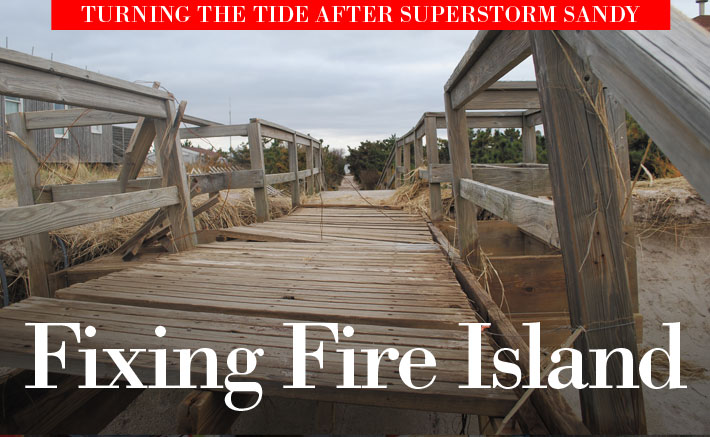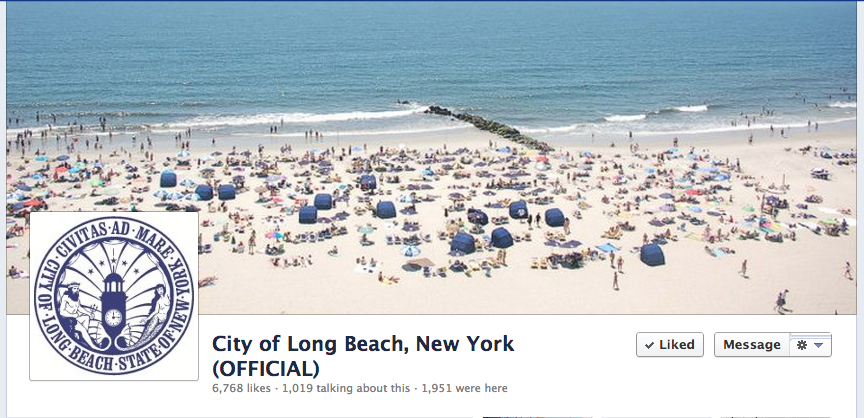

Mary Parker weathered Superstorm Sandy’s bungalow-rocking winds and storm-of-the-century floodwaters surrounding her remote Davis Park home, a short stroll up a busted boardwalk from where seven of a dozen Fire Island houses were swallowed by the sea.
The Davis Park Association president was without power three weeks later, yet still her usual upbeat self. Big questions loom about rebuilding 150 storm-damaged houses and leveled dunes on the 32-mile-long barrier island, Long Island’s main defense against erosion. Hampering recovery is a new breach linking the Atlantic Ocean to Bellport Bay in a nearby preserve, erasing part of the beach that’s a key off-road route to mainland LI used by residents, contractors and first responders.
“I wouldn’t wanna do that again,” Parker tells the Press, describing one of the few certainties for her and 119 others who ignored the island’s evacuation order. “It was one of the most frightening experiences I’ve ever been through.”
Now, she and countless others fear more floods caused by the breach—one of two on FI among three Sandy formed when the ocean washed over the four barrier islands. Compounding the crisis is an ideological showdown between two federal agencies over whether to repair the westernmost breach, never mind next summer.
The controversy is just the latest of many kicked up by the devastating Oct. 29 hurricane that left nearly 200 dead nationwide, displaced 40,000 New Yorkers and ranks second costliest to Katrina.
“We have to get them off their asses,” Ocean Beach Village Mayor James Mallott said at a Manhattan meeting earlier this month, urging a crowd of about 1,000 Fire Islanders to lobby for beach sand replenishment. “Fire Island is the natural levy for Long Island.”
The U.S. Army Corps of Engineers is closing the breaches at Cupsogue and Smith Point county parks in Westhampton and Shirley, respectively, on either side of Moriches Inlet. The $7.25-million job is mostly federally funded with New York State and Suffolk County splitting 30 percent of the tab, 70 to 30.
The National Park Service (NPS), which oversees the Fire Island National Seashore (FINS), has yet to okay filling in the third breach at Old Inlet—named for its status as a former Colonial-era waterway—in the Otis Pike High Dune Wilderness Area, an 8-mile stretch of all-natural, undeveloped beach between Watch Hill and Smith Point. It’s one of the thinnest stretches of the island.
New York State Department of Environmental Conservation Commissioner Joe Martens last week toured Cupsogue, where he viewed dredging equipment maneuvering into place offshore and declared successful the first use of the Breach Contingency Plan, which was enacted after a December 1992 nor’easter ripped Westhampton Beach in half.
“This is not history repeating itself,” he said of the ’92 breach, which grew wider and costlier after months of inaction. “We actually think we can do this quicker in the future.”
Col. Paul Owen, New York District commander for the U.S. Army Corps of Engineers, toured the site with Martens, adding, “I think we were fortunate that the breach hasn’t widened.”
A previous breach on FI came the following year in Water Island—a reclusive community between Fire Island Pines and Davis Park. The feds fixed that one because it was near a residential community. The current disputed FI breach prompted lawmakers to call on NPS to expedite its closure.
“The National Parks Service needs to drop any objections and allow for the final breach in Fire Island to be closed to protect homeowners in Sayville, Patchogue, Bellport, Mastic and all along the South Shore of Long Island,” Sen. Charles Schumer (D-NY) said at a news conference while flanked by local lawmakers and homeowners.
Parks officials declined to respond to the criticism but say they are equally concerned with the safety of LI’s bay-front communities and will act if the breach doesn’t close naturally.
“It appears to be closing on its own,” FINS Superintendent Chris Soller says, noting that Old Inlet had done the same following past breaches. “Sand is moving into the breach.”
LINE IN THE SAND
Much has been said about the therapeutic effects of spending time at the beach—a study exploring that theme for FI’s master plan was released just last summer. But even once the breaches are closed, a stroll along the shoreline these days can be more of a traumatic experience for beachgoers who’ve seen the mostly flattened protective dunes.
“Welcome to Iraq,” says Nicole Rejnie, who tries to reason why her summer home in Ocean Bay Park—one of the hardest-hit sections of FI—was spared the destruction her neighbors’ were dealt, including three homes smashed together. “It’s just insanity.”
Scott Hirsch, owner of The Island Mermaid in Ocean Beach, took it in stride as he surveyed the damage, such as warped floorboards in a well-worn dance floor. “I think she held up pretty well as far as The Mermaid is concerned,” he said.
“It really looked like a lava flow came through there,” Saltaire Village Mayor Robert Cox said of walkways buried in three feet of sand that are being cleaned up and used to build berms until more permanent beachfront repairs can be made.
Such artificial dune building is a makeshift version of plans to dredge sand-clogged Fire Island Inlet and use the spoils to renourish FI beaches and parts of Jones Beach Island in 2014. Sandy is widely considered to have thrown a wrench in that approach. FI leaders are now hoping to expedite a backup plan before the next big storm hits while they’re left vulnerable.
“We’re not asking for anything anyone else doesn’t get,” says Suzy Goldhirsch, president of the Fire Island Association, who’s fighting the perception of such projects as welfare for rich oceanfront-property owners.
Since most of the 17 communities have contracted beach re-nourishment projects about twice per decade since the early ‘90s, they are considered engineered beaches that qualify for Federal Emergency Management Agency reimbursement—once local officials can navigate the lengthy permitting process.
But some experts maintain it’s unwise to allow private property owners to rebuild destroyed beach homes—especially those in dune zones of dynamic barrier islands during a period of rising sea levels and increasingly frequent and strong Atlantic storms.
“We’ve clearly known better than to develop the coast as we have,” said Steven Resler, a retired state Department of State coastal manager who advocates a strategic retreat and selective fortification policy—not rebuilding lost beach homes, but building a sea wall for lower Manhattan.
Like the slow northward march of the barrier islands themselves, political discussions over how to repair them will likely inch forward one grain of sand at a time.






